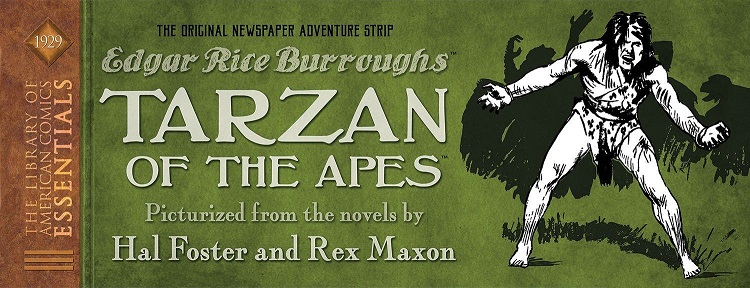
Volume 7 in the Library of American Comics Essentials series focuses on the comic strip starring Edgar Rice Burroughs’ Tarzan. The Lord of the Jungle debuted in 1912 when Tarzan of the Apes appeared on the pages of All-Story Magazine. It was such a sensation Burroughs wrote numerous sequels, and allowed the story and character to appear in other medium. Tarzan of the Apes also became the title of a 1918 film and a 1921 Broadway production.
Harry G. Franke III, editor of The Burroughs Bibliophiles, writes a very informative introductory essay explaining how advertising executive Joseph H. Neebe of the Campbell-Ewald Advertising Agency approached Burroughs with the idea of adapting the novels into comic strips and the path taken to eventually make that a reality, from creating the dailies to selling them to newspapers. This book contains the first four storylines, which were based on the first four Tarzan novels (Tarzan of the Apes, The Return of Tarzan, The Beasts of Tarzan, and The Son of Tarzan) and ran in newspapers from January 7, 1929 to March 15, 1930.
The panels for Tarzan paired drawings above text from the novels. Ralph W. Palmer, art department director at Campbell-Ewald, was tasked with adapting the latter, at first working under the restriction that “no more than fifteen percent of the text from the original Tarzan novel could be used,” but that was eventually lifted in order to lengthen a story’s run.
The legendary Hal Foster provided the art for Tarzan of the Apes, which featured five panels in a daily strip. He returned to draw the Sunday strips from September 27, 1931 through May 2, 1937, leaving to create Prince Valiant. Rex Maxon took over the dailies, which were shortened to four panels. Including the three storylines presented here, he drew 24 daily storylines before leaving 1947.
Tarzan of the Apes tells how Lord John Greystoke was born in the jungle, raised by apes, met Jane, and returned to civilization. Though certainly a product of the early twentieth century in its treatment of minorities and women, the story offers a plausible, entertaining scenario for the hero. Return finds Tarzan unsatisfied living in the modern world. Upon his return to Africa, he encounters the Russian villains Nikolas Rokoff and Alexis Paulvitch. Through major coincidences that would only occur in fiction, Tarzan is thrown overboard only to turn up in the same jungle he was raised, and Jane eventually ends up there as well after escaping from a sinking ship. Tarzan also goes in search of the City of Gold.
The Beasts of Tarzan finds Tarzan and Jane back in the jungle yet again after Rokoff and Paulvitch kidnap their infant son, Jack. This story is fun because Tarzan works with the titular creatures, such as Sheeta the panther and a group of apes to rescue his son. Speaking of The Son of Tarzan, the next story jumps ahead to find 12-year-old Jack following in his father’s footsteps and covering some of the same ground as previous stories. While in the jungle, he earns the name Korak the Killer. His “Jane” is a young girl named Meriem, but she is more of an equal to Jack in terms of the focus of the story and is not the frail flower that Jane was.
Foster’s work is very skilled, as seen in the appearance of the characters and his use of shadows. It’s not a surprise he was an influence to so many artists who followed. Maxon, who had more space in terms of both height and width of the panels in which to present the scenes, does a good job but his art isn’t as refined as Foster’s.
While many authors have told Tarzan stories over the hundred-plus years, these strips offer a great opportunity to read Burroughs’ writing. Also, the dimensions of the Essentials book only allows for one day’s panels on each page, making it easier to evoke the experience of those who read the newspapers during the ’30s. Yet no matter how many strips are read in a sitting, this book is highly recommended for fans of adventure stories and comic strips.